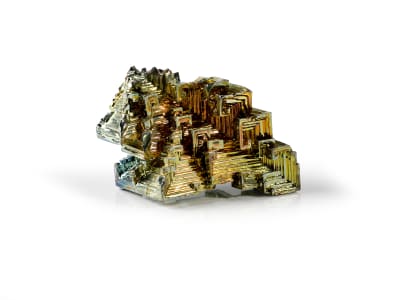Bismuth is rarely found naturally in its elemental form (even less commonly than platinum), but lab-grown crystals are gaining in popularity for their unique geometric formations (hopper crystals) and phenomenal iridescence. Bismuth is a silver-white metal, but an oxide layer forms immediately when crystals make contact with air. This produces an array of colors similar to that of a soap bubble or oil on water. The different colors are dependent upon the thickness of the oxide layer, which determines how light is reflected off of the surface creating a striking rainbow effect.
General Information
Common Name
Bismuth
Species
Bismuth
Transparency
Opaque
Pleochroism
None
Hardness
2-2.5
Streak
Silver White
Specific Gravity
9.700-9.800
Inclusions
Spiral stair-stepped structure
Luster
Metallic
Cleavage
Perfect
Chemical Name
Bismuth
Chemical Formula
Bi
Crystal System
Trigonal
Chemistry Classification
Native Element
Bismuth Colors
-
 Multi-color
Multi-color
Countries of Origin
Canada; Unknown; Germany
